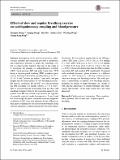Effects of slow and regular breathing exercise on cardiopulmonary coupling and blood pressure
Author(s)
Zhang, Zhengbo; Wang, Buqing; Wu, Hao; Chai, Xiaoke; Wang, Weidong; Peng, Chung-Kang; ... Show more Show less
Download11517_2016_Article_1517.pdf (2.177Mb)
PUBLISHER_POLICY
Publisher Policy
Article is made available in accordance with the publisher's policy and may be subject to US copyright law. Please refer to the publisher's site for terms of use.
Terms of use
Metadata
Show full item recordAbstract
Investigation of the interaction between cardiovascular variables and respiration provides a quantitative and noninvasive approach to assess the autonomic control of cardiovascular function. The aim of this paper is to investigate the changes of cardiopulmonary coupling (CPC), blood pressure (BP) and pulse transit time (PTT) during a stepwise-paced breathing (SPB) procedure (spontaneous breathing followed by paced breathing at 14, 12.5, 11, 9.5, 8 and 7 breaths per minute, 3 min each) and gain insights into the characteristics of slow breathing exercises. RR interval, respiration, BP and PTT are collected during the SPB procedure (48 healthy subjects, 27 ± 6 years). CPC is assessed through investigating both the phase and amplitude dynamics between the respiration-induced components from RR interval and respiration by the approach of ensemble empirical mode decomposition. It was found that even though the phase synchronization and amplitude oscillation of CPC were both enhanced by the SPB procedure, phase coupling does not increase monotonically along with the amplitude oscillation during the whole procedure. Meanwhile, BP was reduced significantly by the SPB procedure (SBP: from 122.0 ± 13.4 to 114.2 ± 14.9 mmHg, p < 0.001, DBP: from 82.2 ± 8.6 to 77.0 ± 9.8 mmHg, p < 0.001, PTT: from 172.8 ± 20.1 to 176.8 ± 19.2 ms, p < 0.001). Our results demonstrate that the SPB procedure can reduce BP and lengthen PTT significantly. Compared with amplitude dynamics, phase dynamics is a different marker for CPC analysis in reflecting cardiorespiratory coherence during slow breathing exercise. Our study provides a methodology to practice slow breathing exercise, including the setting of target breathing rate, change of CPC and the importance of regular breathing. The applications and usability of the study results have also been discussed.
Date issued
2016-05Department
Harvard University--MIT Division of Health Sciences and TechnologyJournal
Medical & Biological Engineering & Computing
Publisher
Springer Berlin Heidelberg
Citation
Zhang, Zhengbo et al. “Effects of Slow and Regular Breathing Exercise on Cardiopulmonary Coupling and Blood Pressure.” Medical & Biological Engineering & Computing (2016): n. pag.
Version: Author's final manuscript
ISSN
0140-0118
1741-0444